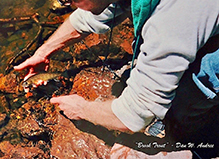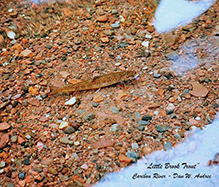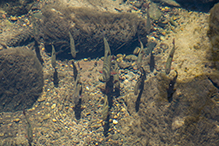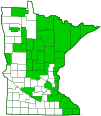brook trout
(Salvelinus fontinalis)
Conservation • Description • Habitat • Ecology • Distribution • Taxonomy
|
|
||||||||||||||
Description |
Brook trout is a medium-sized freshwater fish. It is native to eastern United States and southern Canada from Newfoundland west to eastern Minnesota, south to northern New Jersey and eastern Iowa, and also south along the Appalachian Mountains to northern Georgia. It is a popular sport fish and has been stocked around the world since the 1800s. It is now widely distributed and locally established across Europe, Canada, and the United States. In Minnesota it is most common in the northeast. It is found in small, spring-fed streams that are cool, no more than 66°F; well oxygenated; and clear, mostly free of siltation. Brook trout is a medium-sized freshwater fish. It lives an average of 6 to 8 years in the wild in its native range, but has been known to survive up to 24 years in other areas. It is 2″ to 3″ long at 5 months, 4″ to 6″ at 1 year, and 8″ to 9″ at 2 years. The average length at maturity is 15″ to 20″, though in Minnesota the average length is reported as just 8″ to 10″ (Minnesota DNR). The body is long, streamlined, and slightly compressed laterally. It is deepest at or just before the dorsal fin. The mouth is large. During breeding season the male develops a hook (kype) on the lower jaw. The back is olive-green to dark brown or almost black with numerous worm-like pale spots (vermiculation). The sides are lighter with numerous round pale spots and smaller red spots. Each red spot has a thin bluish halo. The belly is silvery white. The dorsal fin has 10 to 14 principal rays, the anal fin has 9 to 13 rays, the pelvic fin has 8 to 10 rays, and the pectoral fin has 11 to 14 rays. Between the dorsal and caudal fins there is a small, fleshy, adipose fin. The dorsal fin is pale with heavy, wavy, black lines. The pectoral, pelvic, and anal fins are mostly reddish with a white leading edge and a contrasting black stripe. The caudal fin is nearly straight or shallowly indented or slightly forked. During spawning season the sides and fins of the male often become bright orangish-red. |
Size |
8″ to 20″ |
Similar Species |
Habitat |
Streams and lakes |
Ecology |
Behavior |
|
Lifespan |
Average 6 to 8 years |
Life Cycle |
|
Food |
Insects, crustaceans, and other fish |
Distribution |
||
|
Sources Biodiversity occurrence data published by: Minnesota Biodiversity Atlas (accessed through the Minnesota Biodiversity Atlas Portal, bellatlas.umn.edu, 2/14/2024). Nonindigenous Aquatic Species (NAS) information resource for the United States Geological Survey Mundahl, N.D. 1994. Distribution of fish species within ten watersheds in southeastern Minnesota. Final report submitted to the Minnesota Department of Natural Resources. Unpaged. |
|
| 2/14/2024 | ||
Occurrence |
||
Common |
||
Taxonomy |
|
Gigaclass |
Actinopterygii (ray-finned fishes) |
Superclass |
Actinopteri |
Class |
Teleostei |
Order |
Salmoniformes (salmons, pikes, and mudminnows) |
Suborder |
Salmonoidae (salmons, trouts, and whitefishes) |
Family |
Salmonidae (salmons, trouts, and whitefishes) |
Subfamily |
Salmoninae (salmons and trouts) |
Genus |
Salvelinus (chars) |
The taxonomy of fishes above the rank of order is in flux, and it seems that no two sources agree. ITIS does not agree with Catalogue of Life, and neither agree with iNaturalist. Wikipedia is inconsistent – it does not even agree with itself. MinnesotaSeasons will follow the ranking of Catalogue of Life for the higher level (supraordinal) taxonomy. |
|
Subordinate Taxa |
|
aurora trout (Salvelinus fontinalis timagamiensis) brook trout (Salvelinus fontinalis fontinalis) silver trout (Salvelinus fontinalis agassizii) |
|
Synonyms |
|
|
|
Common Names |
|
brook trout brookie charr coaster brook trout salter sea trout speckled trout squaretail trout |
|
Visitor Photos |
||
Share your photo of this fish. |
||
This button not working for you? |
||
Dan W. Andree |
||
Headless Brook Trout... I didn’t get the whole head area in. I had the fish still on the line just above the river and quick took a photo then released it back into the river. It was the last day of stream trout season and the male brook trout was colored up pretty good. It was the biggest brook trout I had caught. They don’t get real big in many streams. It was maybe 10-11 inches something like that. This one was caught in the Manitou River George H. Crosby Manitou State Park some years back (2004). I had caught a few brook trout that day but released them all right away. One inhaled the small hook too far so just cut the string and released it. The hook would dissolve from I had read previously and trying to get it out would have killed the fish which I didn't want happen. They are beautiful fish. |
 |
|
A Brook Trout I caught and released in... the Caribou River up the North Shore some time ago. I was careful to handle and released them unless I planned on eating a couple. I would sometimes bring a small propane stove I could stuff in a backpack a portable frying pan, Shore Lunch coating and other supplies for frying them up on shore. |
 |
|
A little brook trout in the Caribou River... At a lower or more settled down river level north shore streams can become much less tannin stained and clearer. I had fished for brook trout in the Caribou River several times in the past and caught a few small brook trout. It’s not a large stream so I never expected to catch anything large. Brook trout in the fall color up during the spawning season. I remember catching a few closer to the end of the brook trout fishing season and they (particularly the males) were quite colorful. They seemed to get more colorful just the the trees in fall making for a memorable experience. Brook trout are beautiful fish and an indicator of high water quality in the waters they are found. |
 |
|
Though N. Shore streams are tannin stained and can look like root beer at times the tannin stain or dark stream rivers etc. doesn’t mean the water quality is poor. Tannins are caused from natural decay of plants, leaves, etc. I did a test recently just for the fun with some birch tree leaves this fall that had dropped off the tree. I took 6-7 leaves and put them in a container adding water to it. Within 24 hrs. the water was turning a tint of brown from the decaying leaves. That happens in nature with certain streams and the falling and decaying of leaves, pine, spruce tree needles etc. are some things in nature that can cause tannin staining in streams. |
||
MinnesotaSeasons.com Photos |
||
 |
|
|

Slideshows |
|

Visitor Videos |
||
Share your video of this Fish. |
||
This button not working for you? |
||
|
Other Videos |
||
| Brook Trout in ULTRA HD 4k (Salvelinus fontinalis): Under Water Spawning and Life Cycle The Wooded Beardsman |
About
Dec 27, 2015 Brook Trout (Salvelinus fontinalis) - In the last three months of the year, mature brook trout, aged 2 to 5 years, make their way to suitable spawning locations. - Brook trout seek out very specific areas to deposited their eggs. - Brook trout will key in on gravelly or sandy areas of lake bottoms, creeks, or rivers. In lakes were current is not present, brook trout will find upwelling springs that will serve to aerate the eggs. - Brook trout are a highly sensitive fish species. Only lakes, creeks, and river systems unaffected by pollution and acid rain, with high oxygen content and cool temperatures, offered by up-welling springs or current, will successfully harbour populations of brook trout. - The underwater footage of fish spawning in this video was taken in early December at the base of a long white water run. - Once the females have located suitable spawning habitat, she will use her tail fin to excavate a shallow depression called a "redd" which will serve as a nest for the eggs. - The debris that is turned up is carried downstream by the current. - The female will check the depth and thus suitability of the nest by lowering herself to the river substrate. She tests it by keeping her pelvic, anal, and caudal fins stiff, to see if they touch the bottom. - The more brightly coloured male will closely guard the female and position himself so that he can fertilize the eggs once released. The male makes various advances and passes, nudges, and comes alongside the female so that their bodies touch in order to stimulate her to release her eggs. - When the female is finally ready to deposit her eggs she will drop her anal fin deeply into the depression and then arch her back. Both the male and female will then open their mouths wide and tremble with rapid undulations of their body as the eggs and milt are simultaneously released. - As fertilization occurs externally, more than one male might fertilize the same batch of eggs. - A female may lay between 20 and 5000 eggs depending on her age, overall size, and health. She does not lay her eggs all at once, but instead releases 15 to 60 at a time. - Eggs must be fertilized within the first 3 minutes, but are most successfully fertilized immediately upon release. Fertilization succes rates are often between 80 and 90 percent. - Eggs are frequently eaten by other fish species or can even be cannibalized by other males in the vicinity. Only about 1 to 2 percent of eggs will survive to adulthood. - After spawning, the female will cover the eggs by displacing sand and gravel. She does this with a slow motion sweeping of her tail to gently move gravel over the eggs without touching them. This "postnuptial dance" helps protect the eggs from predators as they develop over the next 3 months. - The female will aggressively drive off any fish that may come near the redd. - After spawning has occurred, the male will lose interest in the female and move off in search of another female building a redd. If the male is persistent, he may fertilize the eggs of multiple females. - The female, on the other hand, will move off a short distance, only to begin cutting a new redd for another batch of eggs. - After about 2 weeks, the eggs will develop eyes. The eggs absorbed oxygen from the water and feed off their yoke sack for nourishment. - At this stage, it is imperative that water remain between 1 to 13 degrees Celsius. Higher temperatures will destroy the eggs, as will sub zero temperatures. - The eggs will hatch sometime between February and March. At this point they will still feed off their yoke sac and are called fry or alevin (aləvən). - Once the yoke sac is used up, usually by March or April, the fry will begin eating plankton or microscopic animals found in the lake or stream. - By the end of the summer, the trout will be 2 to 3 inches long. As they are still quite small, they will spend much of their time hiding under and around rocks, while feeding on small insects and plankton. - Trout will reach sexual maturity when they are around 5 to 10 inches long. - The following clips demonstrate various spawning activity. You will see the female digging out a redd, while the male carefully monitors her movements in anticipation of fertilizing her eggs. You will also see males trying to move in and out compete other males for breeding rights. Enjoy! The Wooded Beardsman Use code "WoodBeard" to get 10% off ASAT Camo: www.asatcamo.com |
| Underwater Wild Series/Brook Trout (Salvelinus fontinalis) - Animalia Kingdom Show Animalia Kingdom - Łukasz Karnatowski |
About
Jan 21, 2018 Underwater camera spotting in water canal. The brook trout (Salvelinus fontinalis) - Pstrąg źródlany, Американская палия, Bachsaibling. 2018 © Lukas Karnatowski |
| Brook Trout (Salvelinus Fontinalis) Spawn of 2015 Castlegate Productions |
About
Dec 2, 2015 Trout spawning in a river area in Northern Wisconsin. The trout you are viewing are brook trout (Salvenlinus Fontinalis)a freshwater fish in the salmon family. Notice the red bellies of the trout and the female cleaning a redd or bed for up to 400 eggs. This was filmed in late November 2015. |

Visitor Sightings |
||
Report a sighting of this fish. |
||
This button not working for you? |
||
MinnesotaSeasons.com Sightings |
||

|
Created: 2/16/2020 Last Updated: © MinnesotaSeasons.com. All rights reserved. |



